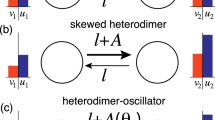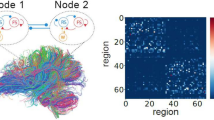Abstract
Astrocytes can sense local synaptic release of glutamate by metabotropic glutamate receptors. Receptor activation in turn can mediate transient increases of astrocytic intracellular calcium concentration through inositol 1,4,5-trisphosphate production. Notably, the perturbation of calcium concentration can propagate to other adjacent astrocytes. Astrocytic calcium signaling can therefore be linked to synaptic information transfer between neurons. On the other hand, astrocytes can also modulate neuronal activity by feeding back onto synaptic terminals in a fashion that depends on their intracellular calcium concentration. Thus, astrocytes can also be active partners in neuronal network activity. The aim of our study is to provide a computationally simple network model of mutual neuron–astrocyte interactions, in order to investigate the possible roles of astrocytes in neuronal network dynamics. In particular, we focus on the information entropy of neuronal firing of the whole network, considering how it could be affected by neuron–glial interactions.





Similar content being viewed by others
References
Haydon, P.G.: Glia: listening and talking to the synapse. Nat. Rev. Neurosci. 2,185–193 (2001)
Atri, A., Amundson, J., Clapham, D., Sneyd, J.: A single-pool model for intracellular calcium oscillations and waves in the Xenopus laevis oocyte. Biophys. J. 65, 1727–1739 (1993)
Wilkins, M., Sneyd, J.: Intercellular calcium spiral waves. J. Theor. Biol. 191, 299–308 (1998)
Izhikevich, E.M.: Simple model of spiking neurons. IEEE Trans. Neural Netw. 14(6), 1569–1572 (2003)
Berridge, M.J., Lipp, P., Bootman, M.D.: The versatility and universality of calcium signalling. Nat. Rev. Mol. Cell Biol. 1, 11–21 (2000)
Izhikevich, E.M.: Which model to use for cortical spiking neurons? IEEE Trans. Neural Netw. 15, 1063–1070 (2004)
Nadkarni, S., Jung, P.: Dressed neurons: modeling neural–glial interactions. Phys. Biol. 1, 35–41 (2004)
Hodgkin, A.L., Huxley, A.F.: A quantitative description of membrane current and application to conduction and excitation in nerve. J. Physiol. 117, 500–544 (1954)
De Pittà, M., Volman, V., Levine, H., Ben-Jacob, E.: Multimodal encoding in a simplified model of intracellular calcium signaling. Cogn. Proc. 10(S1), 55–70 (2009)
De Pittà, M., Volman, V., Levine, H., Pioggia, G., De Rossi, D., Ben-Jacob, E.: Coexistence of amplitude and frequency modulations in intracellular calcium dynamics. Phys. Rev. E 77 030903(R) (2008)
Carmignoto, G.: Reciprocal communication systems between astrocytes and neurones. Prog. Neurobiol. 62, 561–581 (2000)
Magistretti, P.J., Pellerin, L.: Astrocytes couple synaptic activity to glucose utilization in the brain. News Physiol. Sci. 14, 177–182 (1999)
Gebber, G.L., Zhong, S., Lewis, C., Barman, S.M.: Human brain alpha rhythm: nonlinear oscillation or filtered noise? Brain Res. 818(2), 556–560 (1999)
Shannon, C.E.: A mathematical theory of communication. Bell Syst. Tech. J. 27, 379–423 (1948)
Rényi, A.: Probability Theory. North-Holland, Amsterdam (1970)
Chaitin, G.: Algorithmic Information Theory. Cambridge University Press, Cambridge (1988)
Allegrini, P., Giuntoli, M., Grigolini, P., West, B.J.: From knowledge, knowability and the search for objective randomness to a new vision of complexity. Chaos Solitons Fractals 20, 11–32 (2004)
Volman, V., Ben-Jacob, E., Levine, H.: The astrocyte as a gatekeeper of synaptic information transfer. Neural Comput. 19, 303–326 (2007)
Nadkarni, S., Jung, P.: Spontaneous oscillations of dressed neurons: a new mechanism for epilepsy? Phys. Rev. Lett. 91, 268101 (2003)
Hulata, E., Volman, V., Ben Jacob, E.: Self-regulated complexity in neural networks. J. Nat. Comput. 4, 363–386 (2005)
Silvestri, L., Fronzoni, L., Grigolini, P., Allegrini, P.: Event-driven power-law relaxation in weak turbulence. Phys. Rev. Lett. 102, 014502 (2009)
Uhlhaas, P., Singer, W.: Neural synchrony in brain disorders: relevance for cognitive dysfunctions and pathophysiology. Neuron 52(1), 155–168 (2006)
Kang, N., Xu, J., Xu, Q., Nedergaard, M., Kang, J.: Astrocytic glutamate release-induced transient depolarization and epileptiform discharges in hippocampal CA1 pyramidal neurons. J. Neurophysiol. 94, 4121-4130 (2005)
Fellin, T., Gomez-Gonzalo, M., Gobbo, S., Carmignoto, G., Haydon, P.G.: Astrocytic glutamate is not necessary for the generation of epileptiform neuronal activity in hippocampal slices. J. Neurosci. 26(36), 9312–9322 (2006)
Amzica, F., Massimini, M., Manfridi, A.: Spatial buffering during slow and paroxysmal sleep oscillations in cortical networks of glial cells in vivo. J. Neurosci. 22, 1042–1053 (2002)
Tashiro, A., Goldberg, J., Yuste, R.: Calcium oscillations in neocortical astrocytes under epileptiform conditions. J. Neurobiol. 50, 45–55 (2002)
Schwarcz, R.: Early glial dysfunction in epilepsy. Epilepsia 49(S2), 1–2 (2008)
Author information
Authors and Affiliations
Corresponding author
Rights and permissions
About this article
Cite this article
Allegrini, P., Fronzoni, L. & Pirino, D. The influence of the astrocyte field on neuronal dynamics and synchronization. J Biol Phys 35, 413–423 (2009). https://doi.org/10.1007/s10867-009-9166-8
Received:
Accepted:
Published:
Issue Date:
DOI: https://doi.org/10.1007/s10867-009-9166-8




